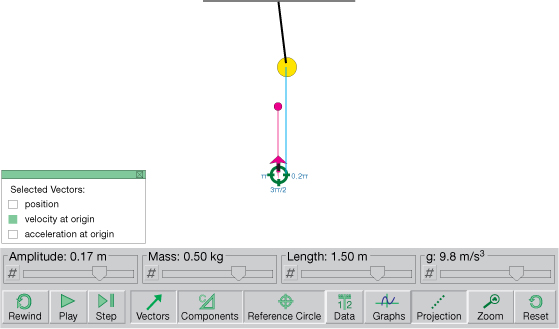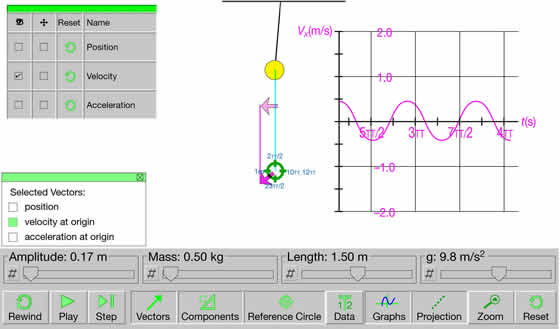Module 7—Oscillatory Motion
 Module 7: Lesson 2 Assignment
Module 7: Lesson 2 Assignment
Remember to submit the answers to TR 4 and TR 5 to your teacher as part of your Module 7: Lesson 2 Assignment.
 Try This
Try This
TR 4. Calculate the period of a 1.50-m pendulum. Verify your answer using the simulation.
TR 5. On the hypothetical planet Xeon, a pendulum with a length of 95.0 cm swings with a frequency of 1.50 Hz. What is the acceleration due to gravity on Xeon?
Simple Harmonic Motion Is Sinusoidal

You saw in Module 7: Lesson 1 that simple harmonic motion (SHM) is sinusoidal in nature.
SHM is also related to uniform circular motion (UCM). Did you notice that the x-axis in the simulation showed radian units? Why would this way of measuring angles be chosen? Could it be because the circumference of a circle is π times the diameter and the writers were trying to make the relationship between SHM and UCM more obvious? Or is it because it makes the formula easier to work with?
Look closely at the similarities between the SHM and the UCM equations. Manipulating the equation for the period of a pendulum in terms of acceleration gives ![]() , which is extremely similar to
, which is extremely similar to ![]() from uniform circular motion.
from uniform circular motion.
This is not surprising if you recall that UCM is vibratory, with a constant period and frequency. Since both equations describe periodic vibratory motion, they should have the same form.
 Module 7: Lesson 2 Assignment
Module 7: Lesson 2 Assignment
Remember to submit the answers to TR 6 and TR 7 to your teacher as part of your Module 7: Lesson 2 Assignment.
 Try This
Try This
Reopen the Simple Harmonic Motion: Pendulum Motion simulation, if necessary, and complete the following questions.
Observe uniform circular motion and simple harmonic motion at the same time by doing the following:
- Reset the simulation (
 ).
).
- Display the "Reference Circle" (
 ), "Vector Components" (
), "Vector Components" ( ), and "Projection" lines (
), and "Projection" lines ( ).
).
- Display the “Vectors” menu (
 ), and select “velocity at origin,” as shown below. You may have to drag the green bar of the “Selected Vectors” popup toward the top of the window to see the choices.
), and select “velocity at origin,” as shown below. You may have to drag the green bar of the “Selected Vectors” popup toward the top of the window to see the choices.
- Press “Play.”

TR 6. Describe one similarity and one difference between the velocity vector on the reference circle and the velocity vector on the pendulum.
Without changing any of the settings from TR 7, turn on the graphing function (![]() ), and select “Velocity” in the first box, as illustrated below. Drag the green bar on the top of the graphing popup to the left so you can see the graph and the pendulum clearly.
), and select “Velocity” in the first box, as illustrated below. Drag the green bar on the top of the graphing popup to the left so you can see the graph and the pendulum clearly.

TR 7.
- How many rotations does the reference circle make for every complete wave (
 ) drawn on the graph?
) drawn on the graph?
- How many complete swing cycles does this represent on the pendulum?